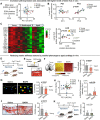Age-related matrix stiffening epigenetically regulates α-Klotho expression and compromises chondrocyte integrity
- PMID: 36627269
- PMCID: PMC9832042
- DOI: 10.1038/s41467-022-35359-2
Age-related matrix stiffening epigenetically regulates α-Klotho expression and compromises chondrocyte integrity
Abstract
Extracellular matrix stiffening is a quintessential feature of cartilage aging, a leading cause of knee osteoarthritis. Yet, the downstream molecular and cellular consequences of age-related biophysical alterations are poorly understood. Here, we show that epigenetic regulation of α-Klotho represents a novel mechanosensitive mechanism by which the aged extracellular matrix influences chondrocyte physiology. Using mass spectrometry proteomics followed by a series of genetic and pharmacological manipulations, we discovered that increased matrix stiffness drove Klotho promoter methylation, downregulated Klotho gene expression, and accelerated chondrocyte senescence in vitro. In contrast, exposing aged chondrocytes to a soft matrix restored a more youthful phenotype in vitro and enhanced cartilage integrity in vivo. Our findings demonstrate that age-related alterations in extracellular matrix biophysical properties initiate pathogenic mechanotransductive signaling that promotes Klotho promoter methylation and compromises cellular health. These findings are likely to have broad implications even beyond cartilage for the field of aging research.
© 2023. The Author(s).
Conflict of interest statement
All authors declare no competing interests.
Figures








Comment in
-
Ageing matrix makes chondrocytes feel old.Nat Rev Rheumatol. 2023 Mar;19(3):127. doi: 10.1038/s41584-023-00928-2. Nat Rev Rheumatol. 2023. PMID: 36750684 No abstract available.
References
-
- Hunter WJPT. Of the structure and diseases of articulating cartilages, by William Hunter. surgeon. 1742;42:514–521.
-
- Centers for Disease Control and Prevention. National Center for Chronic Disease Prevention and Health Promotion, Division of Population Health, accessed 22 Nov 2022, https://www.cdc.gov/arthritis/basics/osteoarthritis.htm.
Publication types
MeSH terms
Substances
Grants and funding
LinkOut - more resources
Full Text Sources
Molecular Biology Databases

